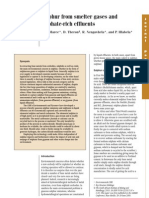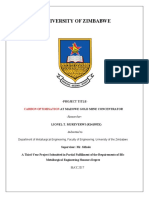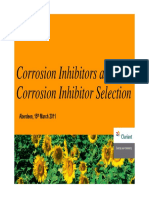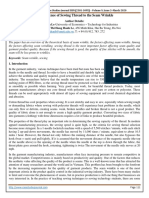Range Sulfur Batubara Kalimantan
Range Sulfur Batubara Kalimantan
Uploaded by
R Kibik ShtCopyright:
Available Formats
Range Sulfur Batubara Kalimantan
Range Sulfur Batubara Kalimantan
Uploaded by
R Kibik ShtOriginal Description:
Copyright
Available Formats
Share this document
Did you find this document useful?
Is this content inappropriate?
Copyright:
Available Formats
Range Sulfur Batubara Kalimantan
Range Sulfur Batubara Kalimantan
Uploaded by
R Kibik ShtCopyright:
Available Formats
COAL, OIL SHALE, NATURAL BITUMEN, HEAVY OIL AND PEAT Vol.
I - Desulfurization of Coal - Yasuo Ohtsuka
DESULFURIZATION OF COAL
Yasuo Ohtsuka
Institute of Multidisciplinary Research for Advanced Materials, Tohoku University,
Japan
Keywords: Biological cleaning, Chemical cleaning, Coal, Desulfurization, Flue gas
desulfurization, In-bed desulfurization, Limestone, Organic sulfur, Physical cleaning,
Pyritic sulfur, Wet scrubbers.
Contents
U
SA NE
M SC
PL O
E
C EO
H
AP LS
TE S
R
S
1. Introduction
2. Sulfur in Coal
2.1 Sulfur Content
2.2 Sulfur Form
3. Coal Cleaning for Sulfur Removal
3.1 Physical Cleaning
3.1.1 Separation Using Specific Gravity Difference
3.1.2 Separation Using Surface Properties
3.1.3 Magnetic and Electrostatic Separation
3.2 Chemical Cleaning
3.3 Biological Cleaning
4. In-bed Desulfurization
5. Flue Gas Desulfurization
5.1 Wet Scrubbers
5.2 Other Flue Gas Desulfurization Processes
6. Conclusion
Glossary
Bibliography
Biographical Sketch
Summary
Sulfur in coal exists in inorganic and organic forms, the former being mostly pyritic
sulfur. Total sulfur contents in major coalfields are in the range of roughly 0.510 wt%.
In coal combustion, to generate electric power and process heat, the sulfur is emitted as
SO2, which is seen as one of the main causes of acid rain. This effect has led to an
interest in the three main methods of removing coal sulfur: coal cleaning, in-bed
desulfurization, and flue gas desulfurization. Coal cleaning includes physical, chemical,
and biological processes. Since physical cleaning is generally based on the differences
in either specific gravity or surface properties between the organic matter in coal and the
associated minerals, it can remove the inorganic sulfur alone. This method is the
commercially proven technology. Chemical or biological cleaning can offer the
potential to remove organic sulfur, but these methods have not yet been used
commercially. Development work is currently directed towards establishing effective,
low-cost techniques. In-bed desulfurization involves the use of Ca-based sorbent, which
captures in situ the SO2 emitted during fluidized bed combustion. Although this high
Encyclopedia of Life Support Systems (EOLSS)
COAL, OIL SHALE, NATURAL BITUMEN, HEAVY OIL AND PEAT Vol. I - Desulfurization of Coal - Yasuo Ohtsuka
temperature desulfurization process is well proven, the reduction of sorbent
consumption is required to minimize the costs for sorbent and residue management.
Flue gas desulfurization (FGD) removes the SO2 from the flue gas of coal-fired plants.
This post-combustion method is the most widely used technology for controlling SO2
emissions. Among commercial FGD processes, wet scrubbers account for more than
80% of the total capacity and achieve SO2 removal efficiencies of more than 90%. The
majority of them uses the limestone (or wet lime)/gypsum system. Spray dry scrubbers
and sorbent injection processes have been used for relatively small to medium capacity
boilers and for retrofitting on existing coal-fired plants.
1. Introduction
U
SA NE
M SC
PL O
E
C EO
H
AP LS
TE S
R
S
Coal is one of the main sources of world energy. Economic growth and industrialization
in developing countries are leading to a rapid increase in the demand for energy; in
other words, an increased demand in the use of coal, which is inexpensive and readily
available, for electric power and process heat. When coal is burned, generally 90% or
more of the sulfur present in it is emitted into the atmosphere as sulfur oxides (mainly
SO2), if no desulfurization methods are used before, during, and after combustion. It is
well-known that SO2 emissions are considered one of the main causes of acid rain,
which leads to the acidification of soils, forests, and surface waters. The growth in coalfired capacity has therefore led to increasing concern about environmental issues, such
as increased emissions of SO2, nitrogen oxides (NOx), trace elements, and particulates,
although most effort has been directed towards the control of SO2 emissions. This
article focuses on the reduction of SO2 emissions in the use of coal, in particular from
coal combustion, and addresses the following options for this purpose:
The use of low-sulfur coal
Pretreatment of coal for sulfur removal.
In situ sulfur capture during combustion.
Post-combustion treatment of flue gas
2. Sulfur in Coal
2.1 Sulfur Content
The total sulfur content of coal can vary within a single deposit as well as between
deposits. As summarized in Table 1, the content for selected coalfields of major coal
producing countries ranges between below 0.5 wt% and roughly 10 wt%. Since coals on
the international market have stricter specifications regarding sulfur and ash content,
however, the former is generally in the range of 0.61 wt%. Global sources of such lowsulfur coals are diverse, with the largest deposits in China, South Africa, Australia,
USA, and Russia. With increasingly stringent environment legislation, coal sulfur
content has become one of the most important factors for fuel choice, and the supply of
low-sulfur coal on the international coal market has increased considerably in recent
years. Nevertheless, major users such as power stations have often been tied to local
supplies of high-sulfur coal because of quality, cost, or policy. In the USA and
Indonesia, for example, many low-sulfur coals are of low rank with decreased calorific
value and increased moisture content, compared with high-sulfur coals. With limited
Encyclopedia of Life Support Systems (EOLSS)
COAL, OIL SHALE, NATURAL BITUMEN, HEAVY OIL AND PEAT Vol. I - Desulfurization of Coal - Yasuo Ohtsuka
supplies of high quality low-sulfur coal, blending with high-sulfur coals may help
utilities meet SO2 emission standards.
Coalfields and Region
Queensland basin
Western
Shanxi
Cerrejon
Ruhr
Raniganj and Jharia
Kalimantan
Upper Silesian basin
Kuznetsk basin
Witbank and Highveld
East Pennine
Illinois basin
Total sulfur content, wt%
0.2-1.3 (air dried)
0.2-1.2
0.4-6.0
0.4-0.9 (air dried)
0.7-0.8
0.5-0.8 (air dried)
0.1-0.9
0.8-1.8
0.3-0.8
0.3-2.4 (air dried)
0.8-4.0
0.2-7.7
U
SA NE
M SC
PL O
E
C EO
H
AP LS
TE S
R
S
Country
Australia
Canada
China
Columbia
Germany
India
Indonesia
Poland
Russia
South Africa
UK
USA
Table 1. Total sulfur contents for selected coalfields of major coal producing countries
2.2 Sulfur Form
Figure 1. Ratio of pyritic sulfur/organic sulfur as a function of total sulfur content
Sulfur present in coal exists as both inorganic and organic forms. The inorganic form is
mostly pyritic sulfur (FeS2), which occurs in two crystalline habits, pyrite (cubic) and
Encyclopedia of Life Support Systems (EOLSS)
COAL, OIL SHALE, NATURAL BITUMEN, HEAVY OIL AND PEAT Vol. I - Desulfurization of Coal - Yasuo Ohtsuka
marcasite (orthorhombic), the former being more common. Although sulfate and
elemental sulfur are also observed, their contents are low. The sulfatic form is mainly
gypsum and iron sulfate, the latter usually resulting from oxidation of pyritic sulfur
during storage.
Pyritic and organic sulfur together account for the large majority of sulfur in coal. The
ratio of the two forms as a function of total sulfur content is shown in Figure 1, where
35 coal samples from major coal producing countries are used. Although there is no
distinct relationship, the ratio is less than two in most samples. Since pyritic sulfur can
be removed by physical cleaning, as mentioned below (see 2.1), it is usually easy to
reduce the total sulfur in the coal with a high ratio of pyritic sulfur/organic sulfur.
U
SA NE
M SC
PL O
E
C EO
H
AP LS
TE S
R
S
The ASTM standard test method (D 2492) applies to the determination of pyritic and
sulfatic sulfur. In this method, briefly, coal particles are first extracted with hot dilute
HCl to remove sulfatic sulfur, and the residue is then extracted with dilute HNO3 to
measure the iron content, which makes it possible to calculate the content of pyritic
sulfur from the 1:2 stoichiometry of FeS2. Organic sulfur is determined by difference;
that is, by subtracting the sum of pyritic and sulfatic forms from total sulfur content, and
is thus subject to the accumulated errors in these measurements. To remove such
uncertainty, some analytical techniques for the direct determination of organic sulfur,
such as chemical and instrumental methods, have recently been proposed.
The forms of organic sulfur are less well established. Organic sulfur compounds have
been identified in extracts and soluble reaction products from coal, and thiophenic
sulfur forms in coal have been evidenced substantially. Chemical methods, such as flash
pyrolysis, temperature-programmed reduction and oxidation, have been used to quantify
organic sulfur forms.
Furthermore, new instrumental quantification techniques, which involve X-ray
photoelectron spectroscopy and X-ray absorption near edge structure spectroscopy, have
recently been developed. Since all of these quantitative analyses rely on models to deconvolute the data, however, there are difficulties in data interpretation. In summary, the
majority of the organic sulfur in high rank coal is in thiophenic forms, and the
proportion of non-thiophenic groups including sulfide forms is higher in low rank coal,
but the presence of thiol forms in coal is unclear. A better understanding of organic
sulfur forms and quantities is essentially needed for chemical and biological coal
cleaning (see 3.2 and 3.3).
3. Coal Cleaning for Sulfur Removal
The coal cleaning process has traditionally focused on reducing ash-reforming minerals
and not necessarily aimed at removing sulfur in coal until recently. However,
increasingly stringent regulations for SOx emissions during coal combustion have
encouraged technical development of coal cleaning for sulfur removal. Physical
cleaning techniques to remove inorganic sulfur forms, mainly pyritic sulfur, are well
established and widely used. On the other hand, chemical and biological cleaning can
offer the potential to remove organic sulfur, but these methods have not yet been
applied commercially.
Encyclopedia of Life Support Systems (EOLSS)
COAL, OIL SHALE, NATURAL BITUMEN, HEAVY OIL AND PEAT Vol. I - Desulfurization of Coal - Yasuo Ohtsuka
3.1 Physical Cleaning
Physical cleaning of coal is essentially based on the differences in either specific gravity
or surface properties between the organic matter and the associated minerals, although a
few separations that are conducted on the basis of their magnetic and electrostatic
properties have been proposed. All of these methods are generally carried out within
three distinct size ranges, that is, coarse (10150 mm), intermediate (0.510 mm), and
fine (< 500 m). Coarse and intermediate sizes are separated by gravity-based methods,
which become increasingly inefficient for smaller particles. Methods based on surface
property differences are then used. Since conventional techniques are not readily
applicable to ultra-fine particles (generally below 100 m), advanced technologies focus
mainly on cleaning ultra-fines.
U
SA NE
M SC
PL O
E
C EO
H
AP LS
TE S
R
S
TO ACCESS ALL THE 15 PAGES OF THIS CHAPTER,
Visit: http://www.eolss.net/Eolss-sampleAllChapter.aspx
Bibliography
Couch G. R. (1991). Advanced coal cleaning technology, IEACR/44, 95 pp. London: IEA Coal Research.
[This highlights physical, chemical and biological cleaning processes.]
Takeshita M. and Soud H. (1993). FGD Performance and Experience on Coal-Fired Plants, IEACR/58,
138 pp. London: IEA Coal Research. [This reviews the performance and experience of flue gas
desulfurization technology.]
Vernon J. L. and Jones T. (1993). Sulphur and Coal, IEACR/57, 62 pp. London: IEA Coal Research. [This
summarizes legislation on SO2 control and reduction of SO2 emissions.]
Biographical Sketch
Yasuo Ohtsuka is an associate professor at the Research Center for Sustainable Materials Engineering,
the Institute of Multidisciplinary Research for Advanced Materials (IMRAM), Tohoku University, and he
is leading the Laboratory of Catalytic Conversion Chemistry. His research interest includes fossil fuels
conversion, heterogeneous catalysis, environmental protection, and porous materials. After receiving a
Ph.D. in applied chemistry at Tohoku University, he joined the Chemical Research Institute of NonAqueous Solutions (the former name of IMRAM). He was a visiting fellow at CSIRO Division of Coal
and Energy Technology, Sydney, in 1988, and at Energy Research Laboratories, CANMET, Ottawa, in
1993. The Fuel Society of Japan (currently the Japan Institute of Energy) awarded him the prize for
advancements in fuel science in 1989. His groups paper presented in the Division of Fuel Science
Symposium at the ACS National Meeting held in 2000 was also awarded the Richard A. Glenn Award.
He is one of the authors in a Japanese textbook entitled Organic Resources Chemistry to be published
in 2002.
Encyclopedia of Life Support Systems (EOLSS)
You might also like
- Professional Sheet Metal Fabrication - Ed BarrDocument305 pagesProfessional Sheet Metal Fabrication - Ed Barrشیخ صادق100% (17)
- The Igoli Mercury Free Gold Extraction Process Acid Bleach LeachingDocument14 pagesThe Igoli Mercury Free Gold Extraction Process Acid Bleach LeachingAFLAC ............100% (2)
- Astm B557Document16 pagesAstm B557unknown171150% (2)
- EPPT-Physical and Chemical Properties of Coal and Its ProductsDocument25 pagesEPPT-Physical and Chemical Properties of Coal and Its ProductsMoly69xNo ratings yet
- UOP Optimized Mercury Removal in Gas Plants Tech PaperDocument18 pagesUOP Optimized Mercury Removal in Gas Plants Tech PaperPherx JhossNo ratings yet
- De NOxDocument21 pagesDe NOxMeow SuthidaNo ratings yet
- 1-Coal Biodesulfurization ProcessesDocument15 pages1-Coal Biodesulfurization ProcessesKhan MuhammadNo ratings yet
- MGSTR 3Document10 pagesMGSTR 3grzmccloudNo ratings yet
- Catalytic OxidationDocument11 pagesCatalytic Oxidationgeetasan100% (1)
- Flue GasDocument3 pagesFlue GasVijay PandaNo ratings yet
- Coal Desulfurization by Solvent Leaching MethodsDocument11 pagesCoal Desulfurization by Solvent Leaching MethodsJhonatan LozanoNo ratings yet
- S From Gypsum SAIMMDocument4 pagesS From Gypsum SAIMMyjurriusNo ratings yet
- Unesco - Eolss Sample Chapters: Environmental Problems Arising From Coal Handling and ProcessingDocument6 pagesUnesco - Eolss Sample Chapters: Environmental Problems Arising From Coal Handling and ProcessingKa EnTeNo ratings yet
- Atmospheric Oxidation of Gold-Bearing Pyrite Concentrates: A Kinetics StudyDocument11 pagesAtmospheric Oxidation of Gold-Bearing Pyrite Concentrates: A Kinetics StudyLevent ErgunNo ratings yet
- v32n2a02Document7 pagesv32n2a02fzl123007No ratings yet
- 25 Articulo Biolixiviacion Carbon Con 2 Bacterias Af y SFDocument7 pages25 Articulo Biolixiviacion Carbon Con 2 Bacterias Af y SFIngeniero PerezNo ratings yet
- Magistr 2Document6 pagesMagistr 2grzmccloudNo ratings yet
- 021 ZachDocument5 pages021 ZachGramlotBlacksmithNo ratings yet
- Anderson Pyro Metallurgy ChapterDocument10 pagesAnderson Pyro Metallurgy ChapterRaybert MartinezNo ratings yet
- Project Full PaperDocument36 pagesProject Full PaperVamsi KrishnaNo ratings yet
- Desulphurization of Petroleum CokeDocument11 pagesDesulphurization of Petroleum CokemauNo ratings yet
- The Presence of Sulphur in Coal Possesses Important Environmetal Problems in Its Usag1Document1 pageThe Presence of Sulphur in Coal Possesses Important Environmetal Problems in Its Usag1rohitsinghNo ratings yet
- SOx Control During Combustion of Coal by Adding LimeStone PDFDocument3 pagesSOx Control During Combustion of Coal by Adding LimeStone PDFAnshu SinghNo ratings yet
- Flue Gas Desulfurizer: An Operational Point of View: by Mahendra & Arif SusetyoDocument11 pagesFlue Gas Desulfurizer: An Operational Point of View: by Mahendra & Arif SusetyoArif SusetyoNo ratings yet
- Lionel CorrectionsDocument23 pagesLionel CorrectionsLeoMessi YdeNo ratings yet
- Rock-Eval Pyrolysis: Lab AssignmentDocument10 pagesRock-Eval Pyrolysis: Lab AssignmentHamza Masood100% (1)
- Interpreting Total Organic Carbon TOC in Source Rock Oil PlaysDocument19 pagesInterpreting Total Organic Carbon TOC in Source Rock Oil PlaysRachdyan NaufalNo ratings yet
- UOP Advanced Mercury Removal Technologies Tech PaperDocument6 pagesUOP Advanced Mercury Removal Technologies Tech Paperrbajuadi100% (1)
- Whitepaper: Overcoming Challenges of Sulfur Analysis in Natural Gas and Gaseous FuelsDocument8 pagesWhitepaper: Overcoming Challenges of Sulfur Analysis in Natural Gas and Gaseous FuelsSiti Fajar karinaNo ratings yet
- 1530 Patrick TaylorDocument65 pages1530 Patrick TaylorEliseo AlcaláNo ratings yet
- Fluorescent Lamps Recycling For The Recovery of Yttrium, Europium and Other REMsDocument6 pagesFluorescent Lamps Recycling For The Recovery of Yttrium, Europium and Other REMsLucca Daré VenturiniNo ratings yet
- Control of Sulphur OxidesDocument10 pagesControl of Sulphur OxidesUmang sharmaNo ratings yet
- Anderson Pyro Metallurgy ChapterDocument10 pagesAnderson Pyro Metallurgy ChapterRunkitoNo ratings yet
- Journal of Environmental Management Volume 183 Issue 2016 (Doi 10.1016 - J.jenvman.2016.08.052) Cerceau, Cristiane Isaac Carvalho, Cornélio de Freitas Rabelo - Recovering Lead From Cupel Waste GeneDocument6 pagesJournal of Environmental Management Volume 183 Issue 2016 (Doi 10.1016 - J.jenvman.2016.08.052) Cerceau, Cristiane Isaac Carvalho, Cornélio de Freitas Rabelo - Recovering Lead From Cupel Waste Geneboanerges wino pattyNo ratings yet
- Air Polluition ControlDocument37 pagesAir Polluition ControlGendewa Tunas RancakNo ratings yet
- Jor Jani 2008Document8 pagesJor Jani 2008conterfoilNo ratings yet
- 2008 IAC 2008 SO2 Emissions Reduction A New Challenge For Aluminium SmeltersDocument8 pages2008 IAC 2008 SO2 Emissions Reduction A New Challenge For Aluminium Smeltersayiep1202No ratings yet
- 1 s2.0 S1876610211001378Document8 pages1 s2.0 S1876610211001378Muhammad NasirNo ratings yet
- (Lee., S. & Park, Y.) Gas-Phase Mercury Removal by Carbon-Based SorbentsDocument10 pages(Lee., S. & Park, Y.) Gas-Phase Mercury Removal by Carbon-Based SorbentsVictor GutierrezNo ratings yet
- Zhao 2016Document7 pagesZhao 2016Andre UvillusNo ratings yet
- L7 PDFDocument24 pagesL7 PDFAnil KumarNo ratings yet
- MOST Process Catalitic Removal of SOx and H2S From Refinery Tail GasDocument6 pagesMOST Process Catalitic Removal of SOx and H2S From Refinery Tail Gasrai rodriguezNo ratings yet
- Removal of Refractory Organic Sulfur Compounds in Fossil Fuels Using Mof SorbentsDocument9 pagesRemoval of Refractory Organic Sulfur Compounds in Fossil Fuels Using Mof SorbentsMohamadMostafaviNo ratings yet
- Xia 2017Document32 pagesXia 2017Anonymous Hm7PkZNo ratings yet
- Iontech Paper 2 Flue DustDocument6 pagesIontech Paper 2 Flue DustGeorgi SavovNo ratings yet
- Solvent Extraction in Production and Processing of Uranium and ThoriumDocument44 pagesSolvent Extraction in Production and Processing of Uranium and ThoriumRubaiyat IshtiNo ratings yet
- 33 1 Toronto 06-88 0265Document9 pages33 1 Toronto 06-88 0265lugoskyNo ratings yet
- 1 s2.0 S0920586108001272 MainDocument6 pages1 s2.0 S0920586108001272 MainGerson Martinez ZuñigaNo ratings yet
- Tomasz Chmielniak, Krzysztof Słowik, Marcin Sajdak: Full Length ArticleDocument9 pagesTomasz Chmielniak, Krzysztof Słowik, Marcin Sajdak: Full Length ArticlevannesaNo ratings yet
- Determination of Boron in Coal Using CloDocument6 pagesDetermination of Boron in Coal Using ClosyakirahNo ratings yet
- Tsyntsarski 2013Document4 pagesTsyntsarski 2013dr.boyko.tsyntsarskiNo ratings yet
- Procimate AnalysisDocument4 pagesProcimate AnalysisEng Qaiser KhanNo ratings yet
- Research Paper Sulphur Fractionation in The Sediments of Cochin EstuaryDocument6 pagesResearch Paper Sulphur Fractionation in The Sediments of Cochin EstuaryShyleshNairNo ratings yet
- IJCCE - Volume 26 - Issue 2 - Pages 35-40Document6 pagesIJCCE - Volume 26 - Issue 2 - Pages 35-40Bekraoui KeltoumNo ratings yet
- Carbonization and Demineralization of Coals: A Study by Means of FT-IR SpectrosDocument12 pagesCarbonization and Demineralization of Coals: A Study by Means of FT-IR SpectrosLuismi Suarez LopezNo ratings yet
- Journal of The Energy Institute: Luning Tian, Wei Yang, Zhenhui Chen, Xianhua Wang, Haiping Yang, Hanping ChenDocument7 pagesJournal of The Energy Institute: Luning Tian, Wei Yang, Zhenhui Chen, Xianhua Wang, Haiping Yang, Hanping ChenBill ChenNo ratings yet
- Energy Engineering 2Document32 pagesEnergy Engineering 2Usama SultanNo ratings yet
- Cyanide DestructionDocument11 pagesCyanide DestructionISMAEL RAMIREZNo ratings yet
- Nearby Analysis and Density of CoalDocument9 pagesNearby Analysis and Density of CoalWendyNo ratings yet
- Clean Coal TechnologyDocument6 pagesClean Coal TechnologyMaitreya SinhaNo ratings yet
- Extractive Metallurgy 2: Metallurgical Reaction ProcessesFrom EverandExtractive Metallurgy 2: Metallurgical Reaction ProcessesRating: 5 out of 5 stars5/5 (1)
- Clean Ironmaking and Steelmaking Processes: Efficient Technologies for Greenhouse Emissions AbatementFrom EverandClean Ironmaking and Steelmaking Processes: Efficient Technologies for Greenhouse Emissions AbatementNo ratings yet
- NWJ s2 Yousra ZghoundiDocument10 pagesNWJ s2 Yousra ZghoundioussamaNo ratings yet
- 336d L Excavators M4t00001-Up (Machine) Powered by c9 Engine (Sebp5387 - 33) - DocumentationDocument11 pages336d L Excavators M4t00001-Up (Machine) Powered by c9 Engine (Sebp5387 - 33) - DocumentationluishvanegasNo ratings yet
- TOC Application - TOC-L - TOC - Determination According To USP 643Document2 pagesTOC Application - TOC-L - TOC - Determination According To USP 643Ramon Trinidad De la ONo ratings yet
- 2011 03 15 Clariant - Corrosion Inhibitors and Corrosion Inhibitor SelectionDocument31 pages2011 03 15 Clariant - Corrosion Inhibitors and Corrosion Inhibitor SelectionVivek PatilNo ratings yet
- Data Sheet Dowcorning 111Document2 pagesData Sheet Dowcorning 111Nyoman RakaNo ratings yet
- Chemical FormulaDocument3 pagesChemical Formulademira lalNo ratings yet
- Indesit Hotpoint-Ariston Aqxl105euDocument13 pagesIndesit Hotpoint-Ariston Aqxl105euGustavo ValdezNo ratings yet
- OA 3961 Zinc Phosphate Primer Product Data: (Exterior / Interior)Document1 pageOA 3961 Zinc Phosphate Primer Product Data: (Exterior / Interior)tshawkyNo ratings yet
- FmeaDocument3 pagesFmeaVishnu RoyNo ratings yet
- Report On Industrial Attachment at Niagara Textiles LimitedDocument53 pagesReport On Industrial Attachment at Niagara Textiles Limitedsadman_sarkerNo ratings yet
- Project Report On Cellular Light Weight ConcreteDocument21 pagesProject Report On Cellular Light Weight ConcreteVishal Kumar100% (1)
- Analysis and Design of Multi-Storied Building (Main Project) Sita GowriDocument114 pagesAnalysis and Design of Multi-Storied Building (Main Project) Sita Gowridskumar49100% (5)
- Modeling Studies To Asses Long Term Settlement PLAXISDocument105 pagesModeling Studies To Asses Long Term Settlement PLAXISAnonymous 5exSerNo ratings yet
- Series 51/52 Flanged Ball Valves: Standard and Anti-Static Valves in ANSI Class 150 and 300Document8 pagesSeries 51/52 Flanged Ball Valves: Standard and Anti-Static Valves in ANSI Class 150 and 300Hafizuddin RazaliNo ratings yet
- Journal of Agriculture and Food Research: Neha Chausali, Jyoti Saxena, Ram PrasadDocument14 pagesJournal of Agriculture and Food Research: Neha Chausali, Jyoti Saxena, Ram PrasadLeonardo PohtsNo ratings yet
- Ics 8 2012 Ready To Publish WatermarkedDocument111 pagesIcs 8 2012 Ready To Publish WatermarkedJesus SalazarNo ratings yet
- Study of Working Mechanisms of Important Components of Automobile EngineDocument5 pagesStudy of Working Mechanisms of Important Components of Automobile EngineNiranjana KarandikarNo ratings yet
- Wrinkle Seam ProblemDocument8 pagesWrinkle Seam Problemdokumen terkontrolNo ratings yet
- Hall Sensors: Ordering Codes, Packaging, Handling: Edition Sept. 12, 2001 6200-249-2EDocument24 pagesHall Sensors: Ordering Codes, Packaging, Handling: Edition Sept. 12, 2001 6200-249-2EbabazadeNo ratings yet
- Site Fundi PDFDocument16 pagesSite Fundi PDFbrian1mugadza0% (1)
- Laguna 2020 en PrintDocument28 pagesLaguna 2020 en PrintDannyNo ratings yet
- Creep Case StudiesDocument11 pagesCreep Case StudiesGeoffrey ArmstrongNo ratings yet
- Quartz Perpetual Calendar User Manual: WWW - Tissot.chDocument3 pagesQuartz Perpetual Calendar User Manual: WWW - Tissot.chKatia EltNo ratings yet
- AP 40 Manual en Rev TR v2Document13 pagesAP 40 Manual en Rev TR v2DamNo ratings yet
- Data Sheet Manual Alarm Call PointDocument4 pagesData Sheet Manual Alarm Call Pointsugeng wahyudiNo ratings yet
- Section 1: Scope of Work Sheet - 14 of 37: CH 1: Steam GeneratorDocument7 pagesSection 1: Scope of Work Sheet - 14 of 37: CH 1: Steam GeneratorMohammad AdilNo ratings yet
- Embraco - EGAS80HLPDocument4 pagesEmbraco - EGAS80HLPMarquesNo ratings yet

























































































